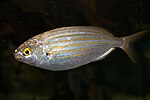Cymodocea nodosa is a species of seagrass in the family Cymodoceaceae and is sometimes known as little Neptune grass. As a seagrass, it is restricted to...
11 KB (1,065 words) - 10:01, 5 May 2024
Islands; Vanuatu; Yemen accepted species Cymodocea angustata Ostenf. - northwestern Australia Cymodocea nodosa (Ucria) Asch. - Mediterranean from Portugal...
3 KB (267 words) - 16:08, 19 September 2023
substitutes were tested as a substitute for the Portuguese floor. Cymodocea nodosa, Zostera marina, and Zostera noltii were given to an adult S. salpa...
14 KB (1,677 words) - 19:01, 28 June 2024
coast are dominated by posidonia oceanica, halophila stipulacea and cymodocea nodosa. Posidonia oceanica is mostly abundant in the shallow waters and can...
7 KB (380 words) - 00:30, 12 July 2023
until it was discovered in Las Canteras. The little Neptune grass (Cymodocea nodosa) is a type of marine phanerogam that once formed extensive meadows...
80 KB (10,648 words) - 13:01, 18 June 2024
"Photosynthetic and morphological photoacclimation of the seagrass Cymodocea nodosa to season, depth and leaf position". Marine Biology. 160 (2): 285–297...
94 KB (9,696 words) - 09:01, 4 July 2024
species are found in the Adriatic Sea. The most common species are Cymodocea nodosa and Zostera noltii, while Zostera marina and Posidonia oceanica are...
185 KB (18,454 words) - 08:38, 1 July 2024
2050 and potentially becoming functionally extinct by 2100, while Cymodocea nodosa would lose ~46% of its habitat and then stabilize due to expansion...
118 KB (13,828 words) - 13:34, 8 July 2024
which is formed by sand and mud and is almost totally covered by Cymodocea nodosa. The six distinct lagoons can be defined by their topographic and hydrological...
9 KB (1,125 words) - 04:08, 29 January 2023
the Mediterranean Sea and it prefers sandy seabed near meadows of Cymodocea nodosa and it lives at depths between 2 and 100 m. This species is active...
4 KB (512 words) - 21:08, 28 December 2023
the littoral sea bottom, from the Stillo Cap to Cuka Channel, while cymodocea nodosa and zostera noltei are widely found along the mouth of Pavllo River...
24 KB (2,535 words) - 17:22, 4 July 2024
seagrass meadows of Zostera marina and Posidonia oceanica. Although Cymodocea nodosa is a preferred food item, it is seldom found in meadows of this seagrass...
9 KB (863 words) - 16:26, 7 January 2024
not final. Bacopa monnieri Crassula aquatica Cryptocoryne ciliata Cymodocea nodosa Helanthium tenellum Juncus roemerianus Myriophyllum spicatum Najas...
2 KB (114 words) - 18:23, 11 October 2023
algae and in the empty shells of mussels near beds of Posidonia and Cymodocea nodosa. Within the beds of Posidonia it is often found in sympatry with Opeatogenys...
1 KB (142 words) - 13:51, 20 November 2021
Sea and it prefers sandy seabed near meadows Posidonia oceanica or Cymodocea nodosa or other mobile seabed in areas very rich in algae from 1 to 50 m deep...
4 KB (437 words) - 08:18, 26 February 2024
seagrasses are dominated by posidonia oceanica, halophila stipulacea and cymodocea nodosa that are mostly to be found in the shallow waters which, however, can...
22 KB (2,231 words) - 04:08, 18 January 2024
2050 and potentially becoming functionally extinct by 2100, while Cymodocea nodosa would lose ~46% of its habitat and then stabilize due to expansion...
30 KB (4,558 words) - 14:42, 8 July 2024
is found on the leaves of seagrasses such as Posidonia oceanica and Cymodocea nodosa and on the fronds of algae, attaching to the leaves or fronds with...
5 KB (548 words) - 01:59, 20 August 2022
Territory. Major habitats and land cover include Zostera marina and Cymodocea nodosa meadows, a tidal zone with endemic species such as Fucus virsoides...
2 KB (281 words) - 07:36, 2 December 2022
programme of planting seagrasses which also involves the planting of Cymodocea nodosa (little Neptune grass). It is found mainly near the inlets or in places...
11 KB (1,496 words) - 00:43, 10 August 2023
muralis". MaltaWildPlants.com. Retrieved 2022-01-04. Mifsud, Stephen. "Cymodocea nodosa". MaltaWildPlants.com. Retrieved 2022-01-04. Mifsud, Stephen. "Cynara...
398 KB (14,701 words) - 21:53, 17 June 2024
antarctica Amphibolis griffithii Cymodocea angustata Cymodocea nodosa, slender seagrass Cymodocea rotundata Cymodocea serrulata Halodule pinifolia Halodule...
254 KB (18,994 words) - 18:00, 26 March 2024
late Paleocene. Fossils of Thalassodendron auriculalopris den Hartog and Cymodocea floridana den Hartog (both extant) were also found in west-central Florida...
12 KB (1,033 words) - 03:36, 8 April 2024
Mediterranean Sea it is found growing in association with the sea grass, Cymodocea nodosa. Phoronopsis californica is a filter feeder. Numerous cilia on the...
3 KB (434 words) - 12:09, 23 December 2023
in the genus Cymodocea. They nourish and shelter many crustaceans and fish that are harvested commercially. Alismatales Cymodocea nodosa Hydrocharitaceae...
24 KB (1,170 words) - 03:50, 16 January 2024
Cymbopogon commutatus Poaceae רב-זקן קירח 781 Cymodocea nodosa Cymodoceaceae גלית גדולה 782 Cymodocea rotundata Cymodoceaceae גלית מעוגלת 783 Cynanchum...
53 KB (178 words) - 14:57, 22 April 2024
lagoon supports dense meadows of aquatic phanerogams, dominated by Cymodocea nodosa. At the mouths of the streams there are freshwater reed beds. Salt...
9 KB (892 words) - 14:03, 29 April 2023
has been recorded feeding on Posidonia oceanica, Zostera marina and Cymodocea nodosa whereas in the Caribbean it consumes Thalassia testudinum, Halodule...
6 KB (710 words) - 07:58, 22 June 2024
lagoon hold a belt 3–4 metres (9.8–13.1 ft) deep of sea grasses such as Cymodocea nodosa and Zostera species that are favorable to the growth of juvenile fish...
12 KB (1,287 words) - 21:34, 17 January 2022
Cymbopogon procerus (R.Br.) Domin Cymbopogon refractus (R.Br.) A.Camus Cymodocea serrulata (R.Br.) Asch. & Magnus Cynanchum carnosum (R.Br.) Schltr. Cynanchum...
86 KB (7,348 words) - 17:39, 17 November 2023




















